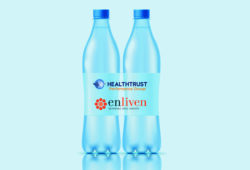How simple changes in operations can make a big difference
Increasingly, hospitals and health systems across the country continue to find ways to protect the planet, while simultaneously reaping the benefits of efficiency and, sometimes, cost savings. Studies also indicate that sustainable actions can help improve an organization’s public perception and lead to increased productivity and a happier staff.
While sweeping changes like installing a new energy system are often thought of as a necessary step, smaller, more concerted efforts within everyday operations can make an impact in improving efficiency and reducing waste.
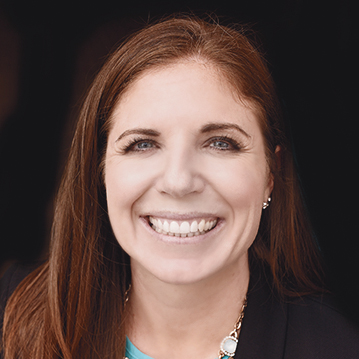
“There are so many touchpoints where hospitals and health systems can affect positive changes, from the supply chain to how patients are treated,” says Zoë Beck, HealthTrust Sustainability Manager. “The healthcare community is a huge consumer of goods with a large supplier base that manufactures those goods. Since hospitals operate 24/7, they are a major consumer of energy. All these things mean there’s a lot of space to have an impact.”
Here are just a few ways members are findings those spaces and making a difference.
Getting creative
Atlantic Health System’s Overlook Medical Center, located in Summit, New Jersey, has reduced its environmental footprint through recycling and energy savings initiatives while at the same time finding unique ways to champion sustainability within the communities it serves.
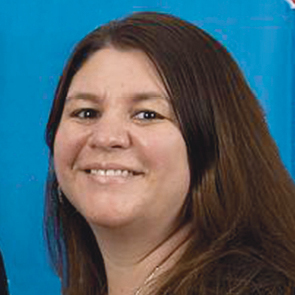
Achieving this level of success comes with challenges, admits Melissa Bonassisa, RDMS, Medical Imaging Supervisor, Overlook Medical Center, and Co-chair of Overlook’s Sustainability Committee, also known as the Green Team. “Healthcare is unique. We’re always juggling environmentally correct decisions and ways to manage infection control—meaning we cannot safely reuse everything. Our top priority is always patient safety and high-quality care, so it is a challenge to find opportunities in which we can also keep our environment safe.”
Here’s a look at two programs Overlook has implemented to creatively champion its commitment to sustainability.
Overlook recently began repurposing a massive amount of surgical blue wrap that covers sterile surgical instruments and materials. This non-biodegradable material is typically thrown away while still sterile, which, according to the U.S. Environmental Protection Agency, amounts to nearly 255 million pounds of annual OR waste.

Tami Ochs, RN, Overlook Inpatient Behavioral Health, saw an opportunity to reduce this statistic. Drawing from her interest in sewing, she created a zero-waste pattern for large and small patient tote bags made from the hospital’s sterile blue wrap waste. Each bag requires roughly 25 minutes to machine-stitch.
After creating several sample totes, Ochs presented the bags to Overlook’s Green Team, which immediately supported the idea. Now, community groups and volunteers help prepare and produce the bags.
“Tami brings the bags to me, I attach an Overlook label, and we distribute the totes to hospital patients—particularly those who arrive due to an emergency situation, without a bag for their belongings. In the past, we gave these patients plastic tote bags,” Bonassisa explains.

In addition, the hospital sells the totes for $2.99 in the gift shop. This revenue could lead to outsourcing the blue wrap tote project and possibly expanding the program throughout the Atlantic Health System to include more products. For example, the Green Team is investigating ways to repurpose blue wrap into sleeping bags and ponchos for local homeless populations.
Moving outside hospital walls, Overlook promotes sustainability within the community it serves.
In 2013, the hospital’s Food and Nutrition Department installed 10 beehives on the Medical Center’s roof, with additional hives added to a neighborhood arboretum.
Today, the hives anchor a full-fledged program called “Bee Healthy.” The honey and beeswax are used in the hospital kitchen as well as for lip balms and lotions sold in the gift shop. Beyond that, Bee Healthy has grown into an educational program for children in local schools and the hospital’s daycare center. “We bring in a beekeeper to speak about how we need to help the bees and how the bees help us by producing healthy food,” Bonassisa explains. “It’s a great example of how a small idea can grow into a powerful way to teach our children about sustainability.”
Stirring up sustainability
HCA Healthcare, based in Nashville, Tennessee, is always scouting out new ways to green healthcare practices. Its corporate-approved sustainability plan includes four task forces that identify and research environmental issues with company-wide application. They are:
- Waste Stream—chaired by Anna Ward, Director of Sustainability
- Energy & Water—chaired by Brian Weldy, VP of Engineering
- Construction & Major Renovation—chaired by Bryan Seely, AVP of Design and Construction
- Environmentally Preferable Purchasing—chaired by Domini Pelkey, Director of Supply Expense Management

Ward is especially proud that the success of the sustainability program includes working with HCA Healthcare colleagues across the company and supporting such efforts within their communities. For instance, sustainability coordinators are appointed at all hospitals. They are responsible for the implementation of sustainability initiatives at the facility level and have introduced programs such as xeriscaping (landscaping that survives on little-to-no irrigation) for water conservation. Grassroots efforts can also be seen in HCA Healthcare’s warehouse locations.
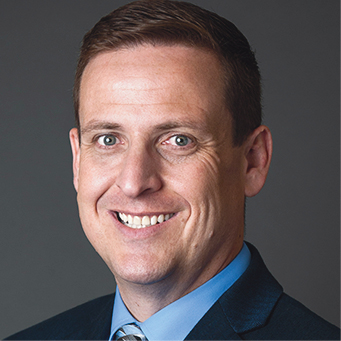
For example, in the Richmond, Virginia, Consolidated Service Center (CSC), “We switched to compostable bamboo coffee stir sticks in our breakroom,” recalls, Steve Vecchione, CFO, Richmond CSC HealthTrust Supply Chain.
It was a move that was ignited by action from Sydnie Rob, now Human Resources Coordinator at Henrico Doctors’ Hospital, who’s always been passionate about sustainability. When the coffee stirrers went over well with employees, Rob decided to expand sustainable efforts with a composting program. She called in a local composting collector to conduct educational sessions for the staff and then set up a three-bin system in the breakroom: one bin for regular garbage, one for recyclables and one for compostables. Next, she filled the breakroom with compostable products, including compostable plates, cups and cutlery. To support her program, Rob and the Employee Advisory Group took a team approach, and developed posters that offered composting instructions and encouraged colleagues to participate.
“Sydnie kept a close watch over the bins, including going through them at the end of the day to make sure no non-compostable items landed in the compostable bins,” Vecchione says. “Her dedication inspired us all to get in the game.”
Ward adds that the strength of these programs can be attributed to both the passion the colleagues bring, as well as strong leadership support at the local and corporate levels. Rob’s efforts were brought to corporate’s attention by the CSC leadership.
Rob’s passion for the effort continues even after taking a role at another of the organization’s facilities. And she has become a member of the Waste Stream Task Force, which Ward chairs. “Sydnie has been a valued contributor to sustainability both in her local community and in efforts that impact our whole company,” Ward adds.
Vecchione reflects on other efforts being made at the CSC: In purchasing and accounts payable, the department focused on reducing its paper consumption. Step one was to identify documents that could be saved as PDFs rather than printed in hard copy format.
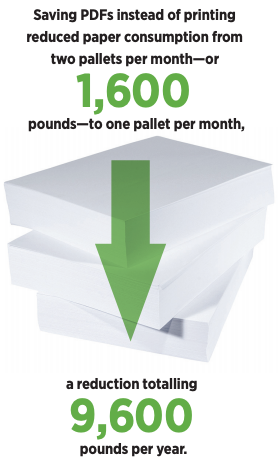
With fewer printouts, the department did not need as many printers. Today the department maintains only five printers, down from 40, and all are equipped with recycled ink cartridges.
The warehouse team focused on sustainably handling cardboard boxes. Instead of putting boxes in the trash compactor, they began breaking down every cardboard box that passes through the warehouse and putting everything in a large corrugated container for recycling.
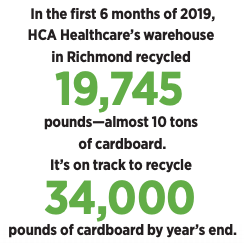
“At first, there was concern that breaking down so many boxes would take too much time and decrease productivity,” Vecchione says. “It turns out that recycling increased productivity. It’s quicker for the team to break down cardboard boxes than stand in long lines to toss boxes in the compactor.”
Whether it’s keeping beehives, implementing composting bins or repurposing blue wrap, today’s leading hospitals and health systems are consistently proving that even small environmentally conscious changes can equal big wins.
Share Email Energy Savings, Operations, Q4 2019